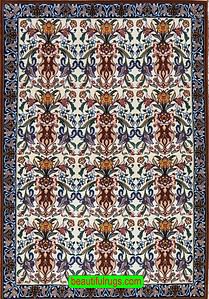The Allure of Kork Wool in Persian Rugs: Why Isfahan Weaving Stands Apart

Among the many treasures of Persian weaving, few materials rival the prestige and refinement of Kork wool. Soft, lustrous, and remarkably durable, this luxurious wool has long been the foundation of Iran’s finest carpets. For centuries, it has been the signature fiber of Isfahan rugs, where master weavers elevate it with silk highlights to create works of art that transcend decoration. In this blog, we will explore what makes Kork wool unique, how it is prepared, its role in history, and why collectors continue to prize Isfahan Kork wool rugs as cultural heirlooms.
What Is Kork Wool?
The term Kork (also spelled kurk) literally means “soft down” in Persian. It refers to the highest-grade wool taken from the neck, underbelly, and first shearing of young lambs. This virgin wool is incredibly fine and silky to the touch, yet it retains the strength needed to withstand generations of use.
Unlike ordinary wool, which may feel coarse, Kork wool offers a texture closer to velvet. Its ability to take on vibrant dyes and hold intricate knotting makes it a natural choice for rugs that demand precision and elegance. For more technical insight, see this authoritative overview of Persian carpet materials on Wikipedia.
How Kork Wool Is Harvested and Prepared
-
Selective Shearing
Only the softest fibers from the lamb’s neck and belly are chosen, ensuring uniformity in texture. These are the most prized parts of the fleece. -
Cleaning and Sorting
The raw wool is carefully washed to remove natural oils and impurities. Skilled artisans then hand-sort it to keep only the finest strands. -
Carding and Spinning
The fibers are aligned and twisted into a thread. This step enhances strength while maintaining the silk-like feel that defines Kork wool. -
Dyeing
Whether through traditional vegetable dyes—such as madder red, indigo blue, or saffron gold—or modern chrome methods, Kork wool accepts color with depth and subtle variation. These tonal shifts, known as abrash, give each rug a living, breathing character. -
Weaving
Using the Persian (asymmetric) knot, artisans weave Kork wool into intricate patterns. In Isfahan, it is often paired with silk foundations or silk highlights, creating dazzling contrasts of matte and sheen.
Historical Significance of Kork Wool in Persian Weaving
The use of Kork wool rose to prominence during the Safavid dynasty (1501–1736), when Persia’s weaving centers flourished under royal patronage. Isfahan, the empire’s capital, became a hub of artistry where the most delicate materials were reserved for court commissions.
Over time, Kork wool became synonymous with Isfahan rugs, which are celebrated for their extraordinary knot counts (often exceeding 500 knots per square inch). This fine material enabled weavers to create detailed medallions, flowing arabesques, and garden motifs that continue to captivate collectors worldwide.
Why Kork Wool Is a Game-Changer for Isfahan Rugs
-
Softness Meets Durability
Kork wool provides a luxuriously soft pile without sacrificing resilience, ensuring rugs remain functional art for centuries. -
Precision and Detail
Its fine fibers allow weavers to achieve exceptionally high knot densities, perfect for Isfahan’s detailed floral and geometric designs. -
Visual Beauty
When paired with silk accents, Kork wool rugs shimmer with contrast and depth, producing a striking interplay of light and shadow.
Caring for Kork Wool Rugs
While Kork wool rugs are highly durable, proper care ensures they retain their beauty for generations:
-
Vacuum Regularly: Use gentle suction without rotating brushes to avoid pulling delicate fibers.
-
Rotate Periodically: This prevents uneven wear and sun fading.
-
Avoid Moisture: Excess humidity can damage wool fibers and natural dyes.
-
Professional Cleaning: Have your rug professionally cleaned every few years by experts like Beautiful Rugs Rug Cleaning & Repair Services to maintain its vibrancy and condition.
By following these practices, a Kork wool rug becomes not just a purchase but a legacy.
A Collector’s Perspective
For serious collectors, Isfahan Kork wool rugs represent the pinnacle of Persian artistry. Their combination of refined materials, intricate weaving, and timeless design makes them highly desirable. These rugs are often displayed as the centerpiece of a home, a statement of cultural sophistication. Beyond decoration, they are investments—artifacts of history that appreciate in value as their rarity increases.
At Beautiful Rugs Chicago, we specialize in fine Isfahan Kork wool rugs with silk highlights and silk foundations, handpicked for their excellence in craftsmanship. Owning one is not only acquiring a rug—it is embracing centuries of heritage woven into a masterpiece.
Conclusion
Kork wool is more than a fiber; it is the lifeblood of Persian weaving excellence. Its softness, strength, and ability to capture intricate designs have made it the hallmark of Isfahan rugs for centuries. To own a Kork wool rug is to possess a cultural treasure that combines elegance, durability, and history.
Whether displayed in a living room, library, or private collection, a Kork wool rug from Beautiful Rugs Chicago offers more than beauty—it offers legacy.